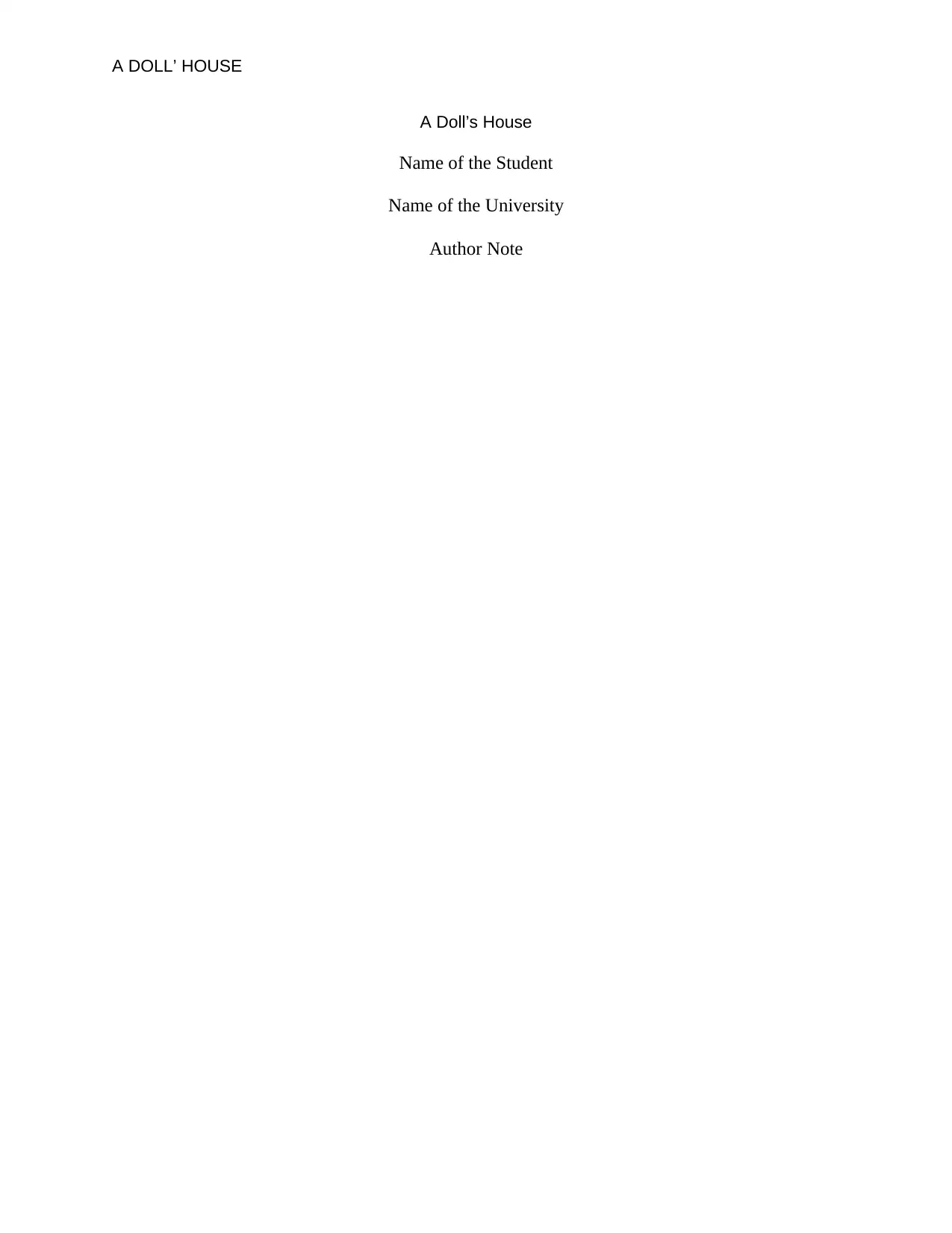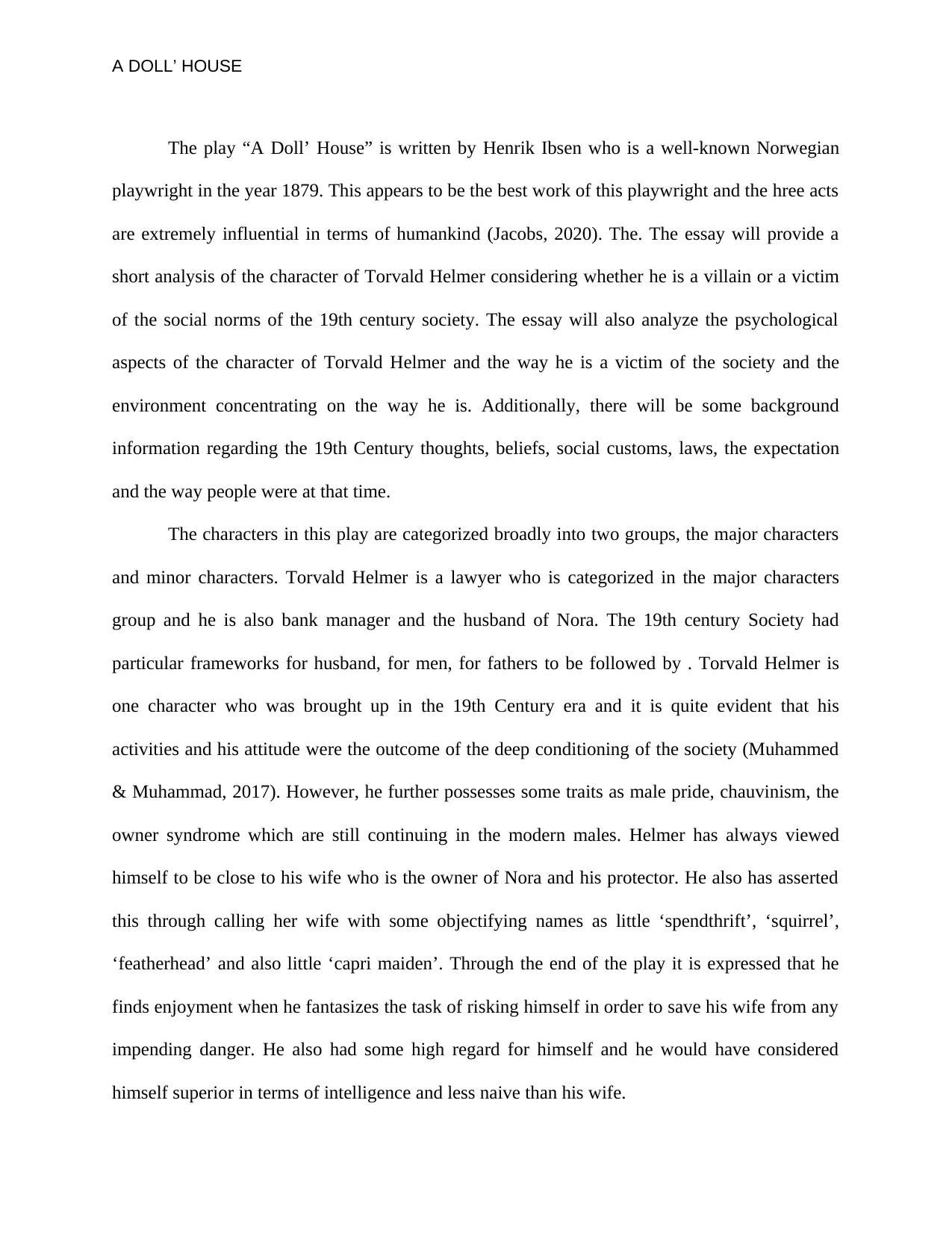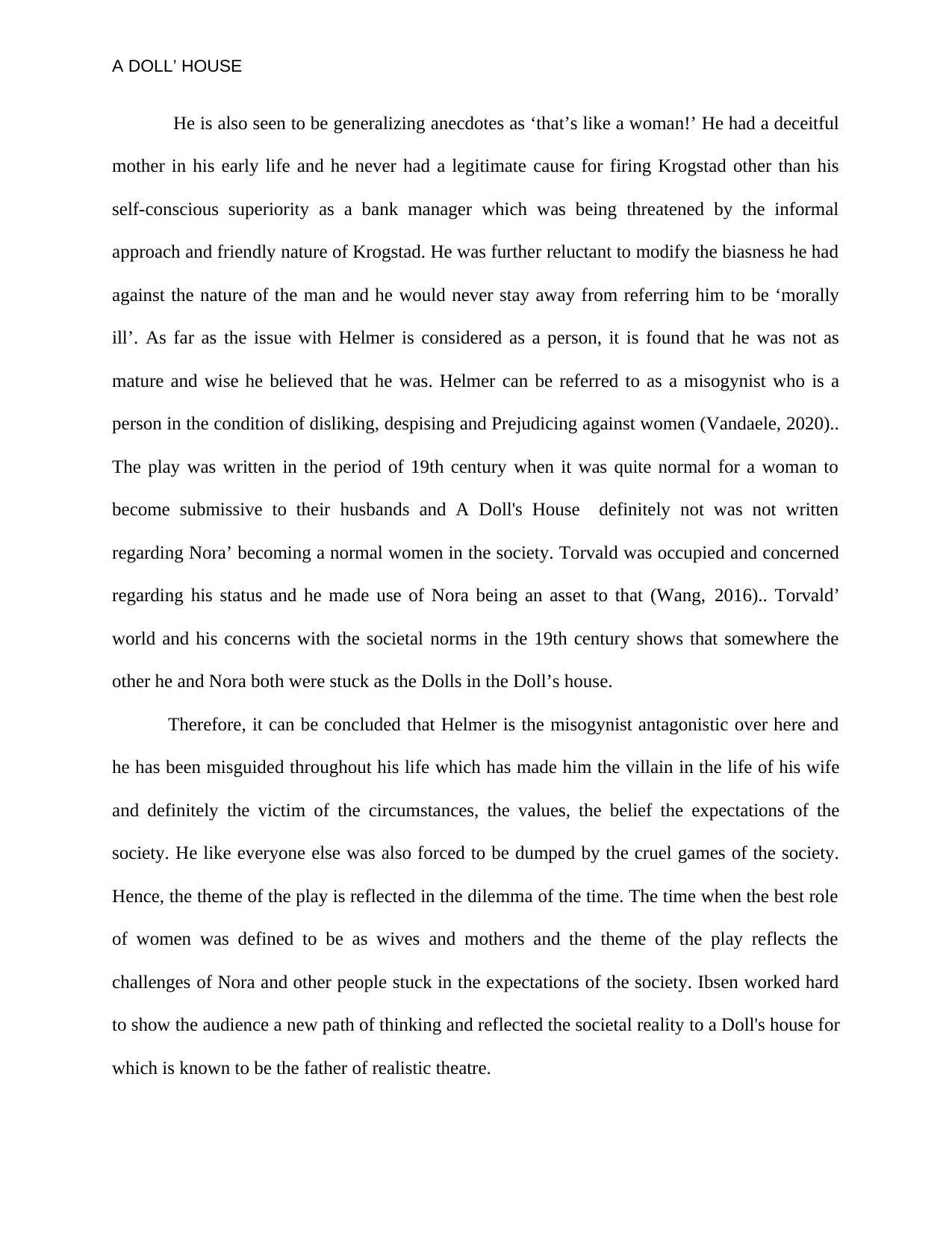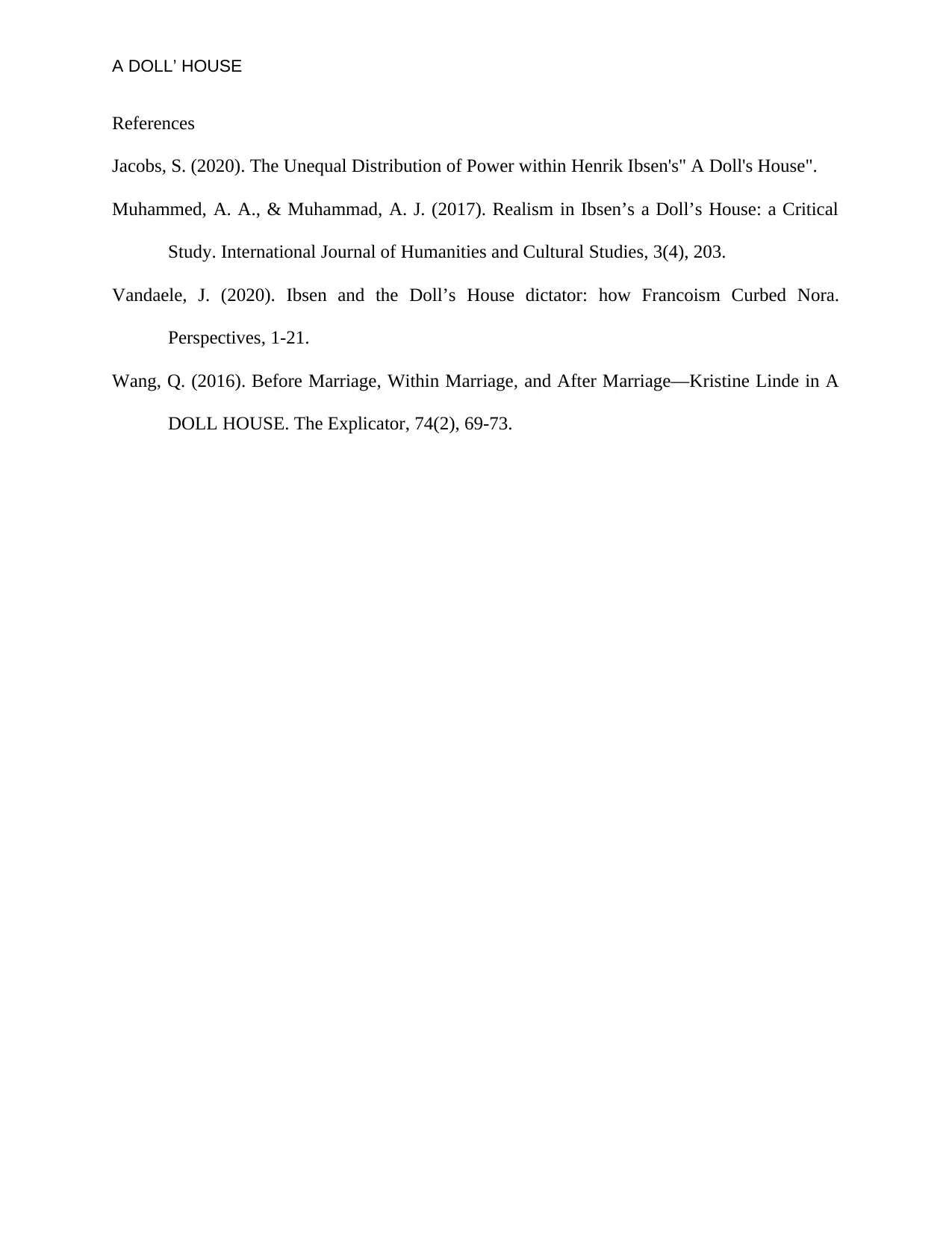A Doll's House: Torvald Helmer's Role in 19th Century Society
VerifiedAdded on 2022/08/27
|6
|959
|32
Essay
AI Summary
This essay provides an analysis of Torvald Helmer from Henrik Ibsen's play, 'A Doll's House.' It examines his character, motivations, and the societal context of 19th-century norms. The essay considers whether Helmer is a villain or a victim of his time, exploring his male pride, misogyny, and the expectations placed upon him. It delves into his relationship with Nora and his interactions with other characters like Krogstad, highlighting his self-perceived superiority and the impact of societal conditioning on his behavior. The analysis references the play's themes of gender roles, societal expectations, and the challenges faced by individuals within a restrictive social framework. The essay concludes that Helmer, while exhibiting villainous traits, is also a product of his environment, reflecting the dilemmas of the time and the constraints placed upon both men and women.

A DOLL’ HOUSE
Paraphrase This Document
Need a fresh take? Get an instant paraphrase of this document with our AI Paraphraser

A DOLL’ HOUSE
A Doll’s House
Name of the Student
Name of the University
Author Note
A Doll’s House
Name of the Student
Name of the University
Author Note

A DOLL’ HOUSE
The play “A Doll’ House” is written by Henrik Ibsen who is a well-known Norwegian
playwright in the year 1879. This appears to be the best work of this playwright and the hree acts
are extremely influential in terms of humankind (Jacobs, 2020). The. The essay will provide a
short analysis of the character of Torvald Helmer considering whether he is a villain or a victim
of the social norms of the 19th century society. The essay will also analyze the psychological
aspects of the character of Torvald Helmer and the way he is a victim of the society and the
environment concentrating on the way he is. Additionally, there will be some background
information regarding the 19th Century thoughts, beliefs, social customs, laws, the expectation
and the way people were at that time.
The characters in this play are categorized broadly into two groups, the major characters
and minor characters. Torvald Helmer is a lawyer who is categorized in the major characters
group and he is also bank manager and the husband of Nora. The 19th century Society had
particular frameworks for husband, for men, for fathers to be followed by . Torvald Helmer is
one character who was brought up in the 19th Century era and it is quite evident that his
activities and his attitude were the outcome of the deep conditioning of the society (Muhammed
& Muhammad, 2017). However, he further possesses some traits as male pride, chauvinism, the
owner syndrome which are still continuing in the modern males. Helmer has always viewed
himself to be close to his wife who is the owner of Nora and his protector. He also has asserted
this through calling her wife with some objectifying names as little ‘spendthrift’, ‘squirrel’,
‘featherhead’ and also little ‘capri maiden’. Through the end of the play it is expressed that he
finds enjoyment when he fantasizes the task of risking himself in order to save his wife from any
impending danger. He also had some high regard for himself and he would have considered
himself superior in terms of intelligence and less naive than his wife.
The play “A Doll’ House” is written by Henrik Ibsen who is a well-known Norwegian
playwright in the year 1879. This appears to be the best work of this playwright and the hree acts
are extremely influential in terms of humankind (Jacobs, 2020). The. The essay will provide a
short analysis of the character of Torvald Helmer considering whether he is a villain or a victim
of the social norms of the 19th century society. The essay will also analyze the psychological
aspects of the character of Torvald Helmer and the way he is a victim of the society and the
environment concentrating on the way he is. Additionally, there will be some background
information regarding the 19th Century thoughts, beliefs, social customs, laws, the expectation
and the way people were at that time.
The characters in this play are categorized broadly into two groups, the major characters
and minor characters. Torvald Helmer is a lawyer who is categorized in the major characters
group and he is also bank manager and the husband of Nora. The 19th century Society had
particular frameworks for husband, for men, for fathers to be followed by . Torvald Helmer is
one character who was brought up in the 19th Century era and it is quite evident that his
activities and his attitude were the outcome of the deep conditioning of the society (Muhammed
& Muhammad, 2017). However, he further possesses some traits as male pride, chauvinism, the
owner syndrome which are still continuing in the modern males. Helmer has always viewed
himself to be close to his wife who is the owner of Nora and his protector. He also has asserted
this through calling her wife with some objectifying names as little ‘spendthrift’, ‘squirrel’,
‘featherhead’ and also little ‘capri maiden’. Through the end of the play it is expressed that he
finds enjoyment when he fantasizes the task of risking himself in order to save his wife from any
impending danger. He also had some high regard for himself and he would have considered
himself superior in terms of intelligence and less naive than his wife.
⊘ This is a preview!⊘
Do you want full access?
Subscribe today to unlock all pages.

Trusted by 1+ million students worldwide

A DOLL’ HOUSE
He is also seen to be generalizing anecdotes as ‘that’s like a woman!’ He had a deceitful
mother in his early life and he never had a legitimate cause for firing Krogstad other than his
self-conscious superiority as a bank manager which was being threatened by the informal
approach and friendly nature of Krogstad. He was further reluctant to modify the biasness he had
against the nature of the man and he would never stay away from referring him to be ‘morally
ill’. As far as the issue with Helmer is considered as a person, it is found that he was not as
mature and wise he believed that he was. Helmer can be referred to as a misogynist who is a
person in the condition of disliking, despising and Prejudicing against women (Vandaele, 2020)..
The play was written in the period of 19th century when it was quite normal for a woman to
become submissive to their husbands and A Doll's House definitely not was not written
regarding Nora’ becoming a normal women in the society. Torvald was occupied and concerned
regarding his status and he made use of Nora being an asset to that (Wang, 2016).. Torvald’
world and his concerns with the societal norms in the 19th century shows that somewhere the
other he and Nora both were stuck as the Dolls in the Doll’s house.
Therefore, it can be concluded that Helmer is the misogynist antagonistic over here and
he has been misguided throughout his life which has made him the villain in the life of his wife
and definitely the victim of the circumstances, the values, the belief the expectations of the
society. He like everyone else was also forced to be dumped by the cruel games of the society.
Hence, the theme of the play is reflected in the dilemma of the time. The time when the best role
of women was defined to be as wives and mothers and the theme of the play reflects the
challenges of Nora and other people stuck in the expectations of the society. Ibsen worked hard
to show the audience a new path of thinking and reflected the societal reality to a Doll's house for
which is known to be the father of realistic theatre.
He is also seen to be generalizing anecdotes as ‘that’s like a woman!’ He had a deceitful
mother in his early life and he never had a legitimate cause for firing Krogstad other than his
self-conscious superiority as a bank manager which was being threatened by the informal
approach and friendly nature of Krogstad. He was further reluctant to modify the biasness he had
against the nature of the man and he would never stay away from referring him to be ‘morally
ill’. As far as the issue with Helmer is considered as a person, it is found that he was not as
mature and wise he believed that he was. Helmer can be referred to as a misogynist who is a
person in the condition of disliking, despising and Prejudicing against women (Vandaele, 2020)..
The play was written in the period of 19th century when it was quite normal for a woman to
become submissive to their husbands and A Doll's House definitely not was not written
regarding Nora’ becoming a normal women in the society. Torvald was occupied and concerned
regarding his status and he made use of Nora being an asset to that (Wang, 2016).. Torvald’
world and his concerns with the societal norms in the 19th century shows that somewhere the
other he and Nora both were stuck as the Dolls in the Doll’s house.
Therefore, it can be concluded that Helmer is the misogynist antagonistic over here and
he has been misguided throughout his life which has made him the villain in the life of his wife
and definitely the victim of the circumstances, the values, the belief the expectations of the
society. He like everyone else was also forced to be dumped by the cruel games of the society.
Hence, the theme of the play is reflected in the dilemma of the time. The time when the best role
of women was defined to be as wives and mothers and the theme of the play reflects the
challenges of Nora and other people stuck in the expectations of the society. Ibsen worked hard
to show the audience a new path of thinking and reflected the societal reality to a Doll's house for
which is known to be the father of realistic theatre.
Paraphrase This Document
Need a fresh take? Get an instant paraphrase of this document with our AI Paraphraser

A DOLL’ HOUSE

A DOLL’ HOUSE
References
Jacobs, S. (2020). The Unequal Distribution of Power within Henrik Ibsen's" A Doll's House".
Muhammed, A. A., & Muhammad, A. J. (2017). Realism in Ibsen’s a Doll’s House: a Critical
Study. International Journal of Humanities and Cultural Studies, 3(4), 203.
Vandaele, J. (2020). Ibsen and the Doll’s House dictator: how Francoism Curbed Nora.
Perspectives, 1-21.
Wang, Q. (2016). Before Marriage, Within Marriage, and After Marriage—Kristine Linde in A
DOLL HOUSE. The Explicator, 74(2), 69-73.
References
Jacobs, S. (2020). The Unequal Distribution of Power within Henrik Ibsen's" A Doll's House".
Muhammed, A. A., & Muhammad, A. J. (2017). Realism in Ibsen’s a Doll’s House: a Critical
Study. International Journal of Humanities and Cultural Studies, 3(4), 203.
Vandaele, J. (2020). Ibsen and the Doll’s House dictator: how Francoism Curbed Nora.
Perspectives, 1-21.
Wang, Q. (2016). Before Marriage, Within Marriage, and After Marriage—Kristine Linde in A
DOLL HOUSE. The Explicator, 74(2), 69-73.
⊘ This is a preview!⊘
Do you want full access?
Subscribe today to unlock all pages.

Trusted by 1+ million students worldwide
1 out of 6
Related Documents
Your All-in-One AI-Powered Toolkit for Academic Success.
+13062052269
info@desklib.com
Available 24*7 on WhatsApp / Email
![[object Object]](/_next/static/media/star-bottom.7253800d.svg)
Unlock your academic potential
Copyright © 2020–2025 A2Z Services. All Rights Reserved. Developed and managed by ZUCOL.





